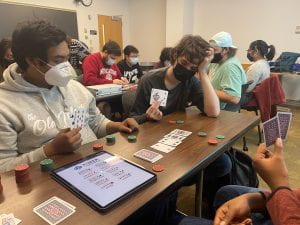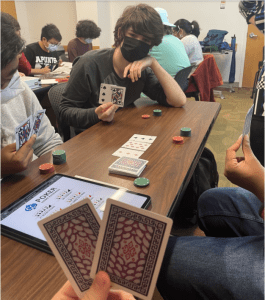For this assignment we were tasked with creating a playable game that involved the use of appropriation. For my game I essentially took Texas hold ‘em style poker and made a single change to the gameplay: the way the cards are held is reversed. The change makes it so that instead of players taking the cards and holding them in a way that stops the other players from seeing them, the cards are held so everyone but the player they belong to knows what they are. I dubbed this version “Reverse Poker”, or simply “Rekop”
The simple act of reversing the way hands are held completely changes the way the game is played. In a conventional game of poker players make decisions based on their confidence in their own hand, and can only theorize as to what other players might have. With the hands reversed, the game is now about weighing the strengths of other people’s hands while trying to figure out how good your own is. In my test games the first few hands felt like shooting in the dark, as without knowing our hands it felt like we lacked vital information needed to make decisions, but as we got more comfortable, viable strategies began to reveal themselves. At one point I was convinced to fold by another player’s confidence in their own hand only to find out my hand was actually much better, and another time I began to play uncharacteristically aggressive because I had figured my hand was statistically the winning since I could see everyone else had complete junk. Effectively the core of the game had changed from convincing others of the strength of your hand to convincing them that their own hand was weak, whether or not it is true. In one memorable instance, one player had three kings —an incredibly strong hand— causing every other player to fold immediately, much to the winner’s bemusement. This led me to discover that unlike in regular poker, where you want your hand to be as strong as possible, in reverse poker the ideal hand is good enough that it beats everyone else’s, but not too good as to discourage other players’ confidence in their hands or to risk using mind games, as the longer the game goes, the bigger the winnings that are up for grabs. I had decided to use the Texas Hold’em variation of poker after comparing it with other variations of the game for two reasons: The first being that I felt that having only two cards in one’s hand would make determining its contents easier for the players, and the second being that Texas Hold’em is very simple and by far the most popular variation of poker which would make it easier for players to pick up my take on it.
The chief inspiration behind my idea was Yoko Ono’s white chess set. This artwork is a game of chess in which every piece and square on the board is painted white. I really enjoy the concept of changing a familiar game so that it adds an extra dimension to it or changes the experience completely. Ono’s change doesn’t render the game unplayable, rather it changes the experience so that players not only have to outmaneuver their opponents, but also remember whose piece is whose. When I was first introduced to this artwork I began to think about how I would have altered the game of chess, and started applying that thinking to other games, eventually coming up with reversed poker. Another inspiration behind my idea are the many different “formats” for playing magic: the gathering, a trading card game. Aside from the standard way to play as prescribed by the official rules, there exist a number of variations that toy with the game’s mechanics, like deck size, life totals, card colors, and creature types. My favorite variation is called commander, which is a format meant for large groups of players that makes massive changes to the standard game. Commander was originally created by fans, and I’ve always enjoyed the fact that actual players have put their own spins on games that they love, which inspired me to put my own spin on things.
The Poker Chips we used in our games were generously provided by my classmate Jackson, who also created a poker based game.

.
